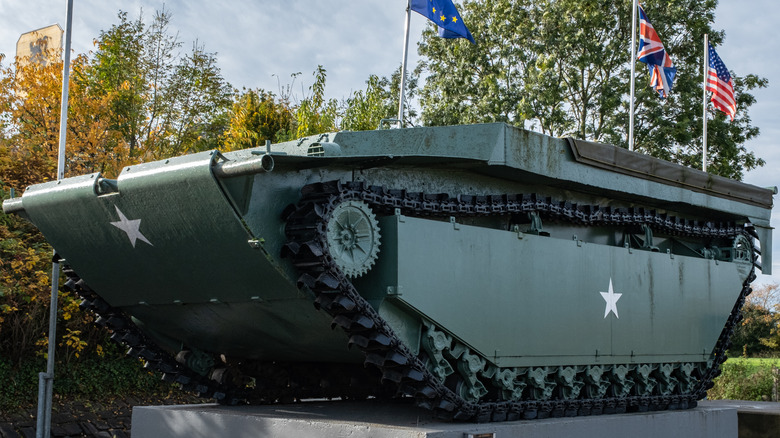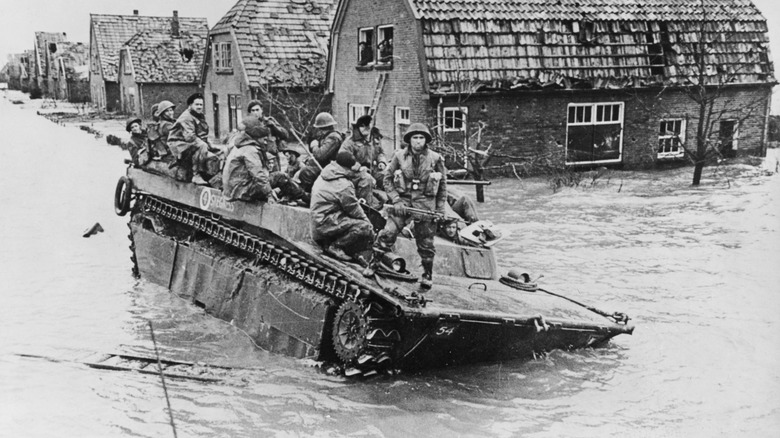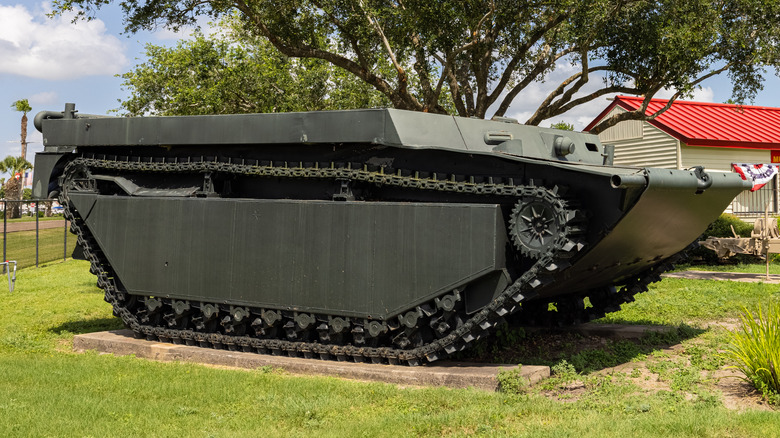How The LVT-4 Water Buffalo Transformed Pacific Warfare In WWII
Imperial Japanese military actions in China (which the U.S. supported) in 1937, their bombing of the U.S.S. Panay (which killed three people) the same year, and their establishment of the Greater East Asia Co-Prosperity Sphere in August 1940, made it obvious to some in the U.S. that it was only a matter of time before we were at war with them. This in turn meant island fighting and to do that, the U.S. needed the capability to get troops ashore over the jagged rocks and coral reefs that were rife throughout the Pacific where the fighting was likely to occur. The Marine Corps took the lead, knowing that the typical Higgins boat landing craft would not survive such conditions, and therefore sought out an alternative.
They would find the 1935 creation of engineer Donald Roebling: A rescue vehicle named the Alligator to be used in the swamps of Florida. Melding the buoyancy of a boat with terrain-crossing tracks, the LVT (Landing Vehicle Tracked) was exactly what the Marines needed, and contracted Roebling in 1940 to develop a military version. The first military version, the LVT-1 arrived in 1941 boasting a top speed of 12 mph, a choice of either two .30 caliber machine guns or two .50 caliber heavy machine guns and with a capacity to transport between 18 and 24 combat troops.
One year later in 1942, the LVT-2 arrived with improvements in hull shape, the suspension system, and the swapping of the engine with the crew cabin from the front to the back. In April 1943 the third version, the LVT-3 Bushmaster, introduced a rear, hydraulic ramp for the first time, along with two Cadillac engines that allowed the craft to travel up to 14 mph on land and 7 mph at sea.
A floating tank made for any terrain
As WWII progressed, so did the further development of the LVT platform to match the needs of the Marine Corps and the Army. This resulted in the production of the LVT-4 beginning in December 1943. Designated the Water Buffalo, the LVT-4 featured a stern ramp that allowed for the transport of 24 soldiers or one small vehicle. To provide the additional cargo space, the engine was moved again to behind the front cabin, and Wash Vanes were installed above the tracks to force water out. The LVT-4 was typically armed with 12.7 and 7.9-millimeter machine guns, along with a .30 caliber ball-mounted gun that was operated by the co-driver.
The LVT in general was crewed by a commander, driver, and co-driver and would have the highest total production numbers of the entire war with over 8,300 being made. The LVT-4 like the other models, would see numerous variations such as the LVT (A)-4 and its 75-millimeter main gun along with enhanced armor protection, essentially making it a floating tank. The Water Buffalo, and its enhancements over previous versions, made it the ideal vehicle to deliver troops and small vehicles (or small artillery) over the razor-sharp coral reefs of Japanese-occupied islands in the Pacific or the flood plains of Northwest Europe.
Making the difference
The island-hopping strategy developed by General Douglas MacArthur and Admirals Chester Nimitz and William "Bull" Halsey required that the U.S. retake less-defended Japanese islands first. Once taken, these islands would be strengthened and then serve as staging grounds for the next attack, as they worked their way toward the Japanese home islands. The LVT-4 Water Buffalo (and other LVTs) provided the protection and capability that was needed by the Marines and the Army to successfully execute the strategy.
The LVT-4 saw its first action at Peleliu in the fall of 1944 when they crossed the island's reef line that was 700 feet from shore, to deliver equipment and men that would not have otherwise been possible. While other versions played important roles in the key battles of Guadalcanal, Tarawa, Saipan, Guam, and Tinian, the LVT-4 became the go-to workhorse in successfully prosecuting the war against not just Japan, but Germany as well. In fact, LVT-4s were used by partner allied nations such as Great Britain and Canada in operations in the Netherlands and the Rhineland between 1944 and 1945. The LVT-4 Water Buffalo dominated the island shorelines of the Pacific Theater much as the Vought F4U Corsair did in the skies, paving the way to victory and proving that sometimes you can have both a boat and a tank in one package.


